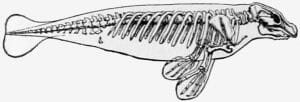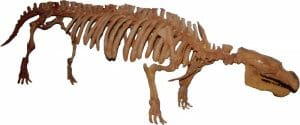Macroevolution Definition
Macroevolution refers to the concept of large-scale evolution that occurs at the level of species and above.
Macroevolution can be used to describe the differences between two closely related but distinct species, such as the Asian Elephant and the African Elephant, which cannot mate due to the barriers imposed by reproductive isolation. This is the process of speciation, which can be driven by a number of different mechanisms. Additionally, macroevolution can describe differences between that organisms belonging to larger clades of organisms, for example the different taxonomic groups within the primates.
The term macroevolution can also be used to explain the shared common ancestry between all living organisms, a concept known as Universal Common Descent. This describes the derivation of all existent and extinct life forms from a single origin, and includes evolutionary milestones such as the origins of plants, mammals, reptiles, birds, fish, non-avian dinosaurs and more.
The term ‘macroevolution’ is often used in contrast to the within-species genetic changes that relate to microevolution, although the two concepts are fundamentally the same, albeit on different time scales; each of the evolutionary mechanisms—mutation, gene flow, genetic drift and natural selection—that alter the gene pool of a population through microevolution, will accumulate over a long time period, resulting ultimately in macroevolution. In the case of Universal Common Decent, microevolution has been driving the macroevolution of living organisms for 3.8 billion years (that’s 3,800,000,000 years!).
While macroevolution can occur due to an accumulation of micro-evolutionary changes, a random event that somehow separates a population into two different populations may also be responsible for the formation of new species. This is called allopatric speciation. For example, individuals in a population of lizards that live in a valley may become separated by the flow of newly formed river. The river makes it impossible for the individuals on each side to interact and breed. Due to the climate and landscape, one side of the valley is lush green vegetation; the other is hot and arid. Over time, each lizard population will adapt to the conditions on each side of the valley. If the interactions between them continue to be restricted, the two populations could become so different that if they were able to reunite, they could no longer breed. The two populations of lizards would be classed as new species and would have increased to the world’s biodiversity through macroevolution.
Creationists more commonly dispute the factual legitimacy of macroevolution than microevolution because microevolution is demonstrable within a lab, whereas macroevolution cannot be observed within the lifetime of a human. There are, however, many ways to observe macroevolution using the evidence available from fossils, geology and radiometric dating, genetics, and the ecology, morphology and behavior of living organisms.
Examples of Macroevolution
The Evolution of Sirenians
The sirenians are a group of mammals within the placental mammals, consisting of the manatees and the Dugong, as well as other extinct species.
Also known as the ‘sea cows’, the sirenians feed solely on sea grass and are the only herbivorous aquatic mammals. They share a common ancestor with the elephants and the extinct mammoths, in a taxonomic group called the Tethytheria. The evidence for the macroevolution that has separated these groups of animals comes from vestigial structures within their bodies.
Firstly, the flippers of sirenians have internal bone structures that are homologous to the bone structure of all other terrestrial tetrapods (four legged animals). Each flipper contains an upper arm bone; two forearm bones, wrist bones, hand bones and five finger bones. On the external tips of their flippers the sirenians have toenails, which are the same as those seen in elephants.

The image shows the skeleton of a manatee. The homologous bone structures are visible in the flippers. Like all other terrestrial mammals, manatees have five finger bones although they have no fingers!
Furthermore, manatees don’t have hind limbs but they do have pelvic bones, which are usually used to support the hind limbs in other tetrapods. Because they lack hind limbs they also don’t have femurs but they have vestigial hip sockets where the femur attaches to the pelvis.
Solidifying the evidence that the sirenians share a common ancestor with other Tethytheria, and have evolved through macroevolution, a 50 million year old fossilized skeleton of a sirenian was found in Jamaica. The fossil had the features of a modern sirenian—including a solid boned skeleton to weigh it down in the water and nostrils on the back its head allowing it to breath at the surface—but it also had four well-developed legs! Several other similar fossil skeletons have also been found with the hind legs, although reduced in size; so reduced that they would not have been able to support the weight of the animal.
From the modern physical evidence of the vestigial structures, as well as the fossil evidence, it is clear that the sirenians share a common ancestor with modern elephants. Originally land-dwelling animals, the ancestors of the sirenians would have utilized the food source of sea grass within marine environments. As the hind limbs are not much use in the water, these became gradually smaller over millions of years until disappearing completely, leaving only some boney reminders of their land-based ancestors.

The image shows the skeleton of the Pezosiren portelli the ancestral form of the sirenians, which has fully formed legs and the other features of modern manatees and dugongs.
Hemoglobin Differences
It is possible to view the evidence for macroevolution through the similarities and differences between the genetic information stored within all living organisms. The genetic information, which determines the characteristics that will be displayed in any organism, is held within strands of nucleotide bases called DNA. The sequence of the nucleotides within the DNA is used as a code, giving precise instructions for the production of amino acids; amino acids are the ‘building blocks’ of proteins, which in turn build living cells.
A strong piece of evidence for the theory of Universal Common Descent comes from the fact that every living organism—except some prokaryotes that contain only RNA, which split from other lineages very early in evolutionary history—use DNA consisting of the same nucleotides, arranged in the same manner, to code for the production of amino acids. Furthermore, the proteins of all organisms are comprised of combinations of exactly the same 20 amino acids, without exception.
Over time and during reproduction, the genetic information is replicated and slight mutations in the sequences of nucleotides occur, resulting in slightly altered DNA strands and thus altered sequences of amino acids and proteins.
Because of these mutations, it is possible to work out how related two organisms are to each other, based on the differences and similarities of their amino acids.
This is well demonstrable with the sequence of amino acids present in a protein that is present in nearly all animals, hemoglobin. Used to transport oxygen around the body, hemoglobin is made up of two sets of identical amino acid chains: one pair consisting of 141 amino acids and the other consisting of 146.
When compared with the amino acid sequences of humans it is possible to see how far diverged we are from certain other organisms, for example the number of amino acid differences in hemoglobin of:
- Gorillas – 1
- Rhesus Monkeys – 8
- Mice – 27
- Chickens – 45
- Frogs – 67
- Lampreys – 125
The ancestors of lampreys split from the jawed fish around 500 million years ago, and the ancestors of humans split from gorillas around 10 million years ago. The differences and similarities between the amino acid sequences of hemoglobin can therefore support the common ancestry between species as well as providing evidence for the times of divergence.
Quiz
1. What is the difference between macroevolution and microevolution?
A. There is more evidence for microevolution
B. They occur on different timescales
C. Macroevolution is easier to measure
D. There is no difference
2. The fact that manatees have five finger bones in their flippers shows:
A. They may some day grow fingers
B. Their common ancestors are fish and the finger bones grew by chance
C. Their flippers have evolved to be useless
D. They share a common ancestor with other five fingered mammals
References
- Austin Cline (2017) Microevolution vs. Macroevolution: What’s the Difference? ThoughtCo. Retrieved from: https://www.thoughtco.com/microevolution-vs-macroevolution-249900
- Bloodsucking Lamprey Found to be “Living Fossil” (1996) National Georgraphic. Retrieved from: http://news.nationalgeographic.com/news/2006/10/061025-lampreys_2.html
- Deoxyribonucleic acid (DNA) (2014) National Human Genome Research Institute. Retrieved from: https://www.genome.gov/25520880/
- Choi, C. Q. (2016) Fossils shed New light on Human-Gorilla Split. Live Science. Retrieved from: https://www.livescience.com/53676-human-gorilla-lineages-split-later.html
Macroevolution
No comments:
Post a Comment